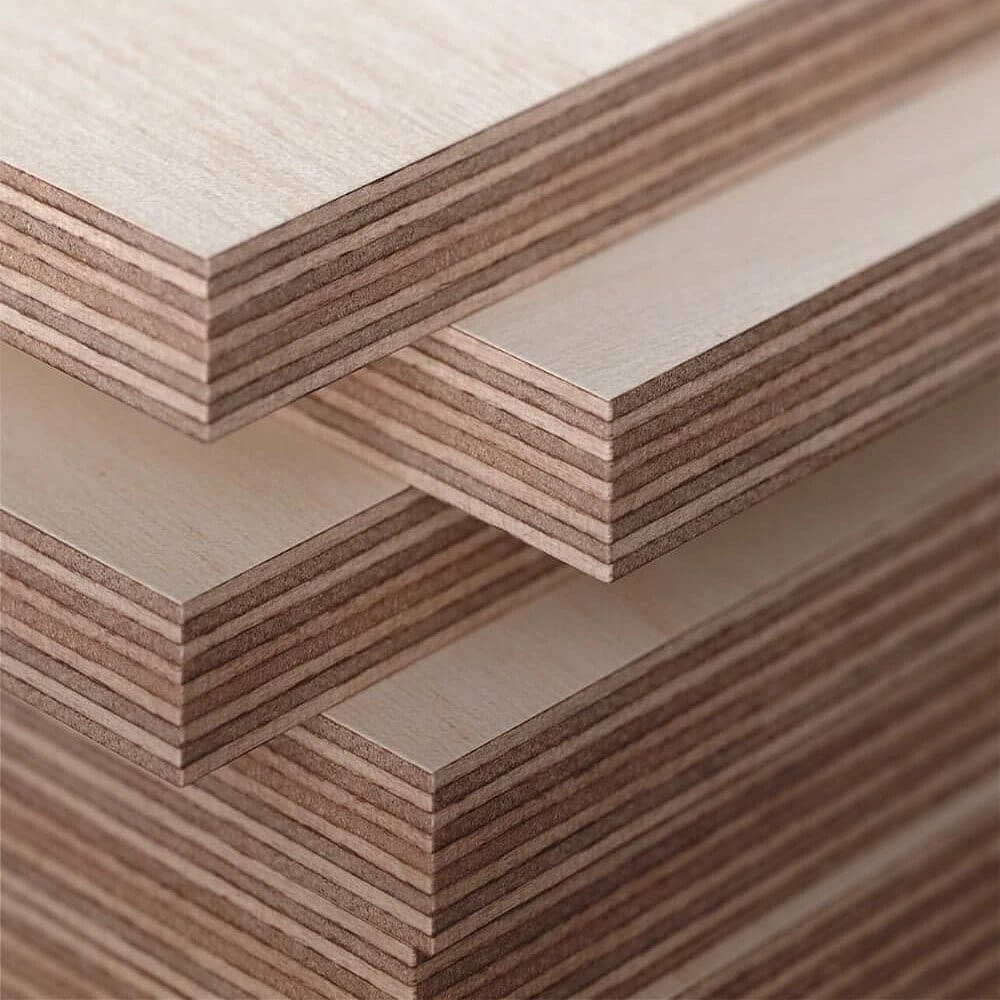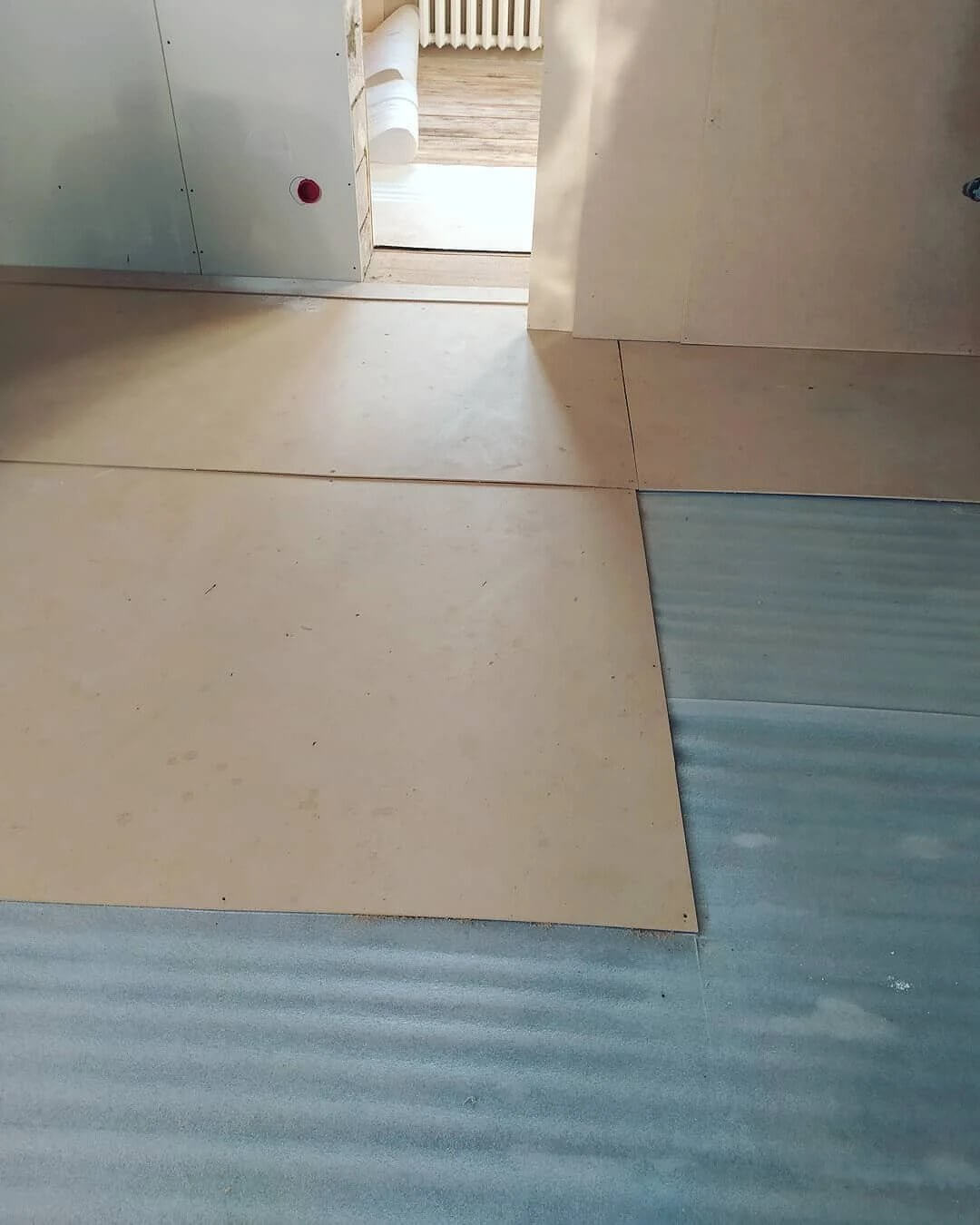Most finishing flooring is demanding on the quality of the subfloor. It must be completely flat and solid. The base is levelled using different methods, most often by laying a concrete screed. This is a laborious and costly undertaking, and it is not always possible to install concrete pavement. A good alternative is wood board levelling. You just need to choose the right material for work. Let’s figure out what is better to lay on the floor: OSB or plywood.
What is plywood
Plywood boards are a kind of layered “cake”. Its basis is coniferous veneer: fir, pine or spruce. Hardwood products are found, but less frequently. Layers, there are at least three of them, are impregnated with adhesive mastic and pressed into a slab. Before glueing, the workpieces are laid so that the fibres of the veneer sheets lying next to it are directed perpendicular to each other. This increases the strength of the product.
The finished plywood sheet is carefully sanded on at least one side. This is sufficient if it will be used as a rough basis. For finishing, take plates sanded on both sides.
The appearance and some qualities of the material depend on its grade. There are four classes of plywood sheets. Their main characteristics are shown in the table.
| Class | Characteristics |
| I | Maximum durability, flawless appearance. Sanded on both sides. There are no surface defects. |
| II | A minimum of minor surface defects, including cracks, are allowed. No additional processing is needed. |
| III | The presence of defects in the form of knots and cracks. Rough surface. The strength is high. Additional processing is required to eliminate defects. |
| IV | A large number of defects: holes, cracks, knots. The surface is not sanded, not processed in any way. |
For the final finishing of the floors, the only class I material is used. For roughing, grades II and III are suitable. The latter option is most often chosen. It is durable and reliable, small coating defects do not affect performance in any way. Moreover, it is cheaper, therefore, it is profitable to lay it.
All about OSB boards
OSB boards, as they are also called, belong to multilayer materials. For their manufacture, shavings and chips of a certain size are used. Usually, it is coniferous wood: spruce, pine, fir. But in some cases, shavings from poplar, aspen and other deciduous trees are also used. The minimum number of layers of chips is three. It is laid strictly oriented, that is, perpendicular to the direction of the previous layer. This makes OSB boards stronger.
Compositions based on natural or synthetic resins are used as adhesive mastic. Finished products can be additionally varnished or laminated. This gives them additional protection. There is also a tongue-and-groove OSB. It is equipped with tongue-and-groove locks for quick and easy connection. Depending on the raw materials used, four classes of OSB boards are distinguished. We have presented their main characteristics in the form of a table.
| Class | Characteristics |
| OSB-1 | Minimum density and strength, low moisture resistance. Used for the production of furniture or as packaging. |
| OSB-2 | Sufficient strength, low moisture resistance. It is installed as a sub-floor in dry rooms. |
| OSB-3 | High strength, high moisture resistance. Wide range of applications including subfloor in rooms with medium to high humidity. |
| OSB-4 | Maximum density and strength, increased resistance to moisture. |
It is recommended to use OSB-3 or OSB-2 for mounting the base under the finishing flooring. They are chosen depending on the humidity of the room. It is not recommended to use OSB-1, it will not withstand loads and will quickly deteriorate from moisture. OSB-4 is a great option, but its price will be high.
Comparison of OSB and plywood by 4 criteria
For levelling the floor and preparing a rough base for the topcoat, both types of wood-based panels are suitable. They have similar performance characteristics. Nevertheless, the similarity is not complete, there are some nuances that you need to know before making the final choice. Let’s compare both materials and conclude which is better: plywood or OSB.
1. Moisture resistance
The water-resistance of both wood-based panels depends on the adhesive with which their layers are impregnated. There may be several options. Almost all oriented strand boards are glued with phenolic resins. They securely “seal” the chips inside the resin casing. It is difficult for water to reach the wood. The most resistant to moisture is OSB-3 and OSB-4 plates. They can be installed in any room.
There are more adhesive mastics for plywood. Depending on which one was used, there are several types of plywood sheets.
- FSF. It is glued with phenol-based compounds. This gives maximum moisture resistance. But there is a possibility that formaldehyde, an extremely dangerous substance for humans, will be released during operation.
- FC. Uses urea adhesives. The finished product has a low moisture resistance. It is not recommended to lay it in damp rooms. If the letter “G” or “B” is also present in the marking, this indicates increased moisture resistance. In this case, the plywood sheet is additionally treated with hydrophobic impregnations.
- FB. Produced with bakelite varnish. This treatment gives a high resistance to water. FBS marking indicates alcohol-soluble bakelite glue. Such plywood, also called aviation plywood, is highly moisture resistant, but very expensive.
- FBV. An analogue of aviation, but for products they use water-soluble bakelite mastic. The sheets are durable, but not moisture resistant. Scope – interior work in rooms with low humidity.
- FBA. The veneer is glued together with albumin-casein glue. It is water-soluble, so the material is used only for indoor work in dry rooms.
It is impossible to draw an unambiguous conclusion which of the materials is more moisture resistant. It all depends on its brand and class. But in general OSB boards are better protected from water, since chips and shavings are hermetically “sealed” in adhesive mastic. Plywood sheets are vulnerable to the outer veneer layers and open side cuts. When exposed to moisture, they swell and warp.
2. Environmental friendliness
Like moisture resistance, environmental safety depends on the composition of the adhesive component. The most environmentally friendly natural substances. They are used to make some brands of plywood. For example, FBA based on albumin-casein glue is environmentally friendly. But even if the adhesive mastic is synthetic, this does not mean that it is dangerous to humans. If all technical requirements are met, the standards for the content of hazardous substances will not be violated.
The most popular brands of OSB boards and plywood sheets are made on the basis of phenolic resins. Over time, they begin to release formaldehyde, a substance extremely toxic to humans. There is a classification developed based on the number of formaldehyde emissions. She divides all materials into four groups. So, slabs of class E0 and E1 are completely safe, they can be laid in residential premises. E2 and E3 are suitable for outdoor use only.
It becomes clear that environmental friendliness depends on the composition of the adhesive mixture. Generally, both materials can be classified as conditionally safe. Therefore, when buying, it is imperative to check with the seller for a certificate of conformity and carefully study it.
3. Strength
We will compare which is stronger, plywood or OSB, on models that are approximately the same in terms of performance. If we take OSB-3 and FSF, then the buckling strength of the first will be from 16-20 MPa and the second – from 22 to 60 MPa. The chip strength of OSB-3 is 0.13-0.34 N per sq. mm, for FSF – 1.2-1.3 N per sq. mm. At the same time, all other things being equal, they withstand approximately the same load.
According to the rules, strength tests are carried out dry, wet and after drying. Plywood keeps all indicators at the same level, but OSB boards reduce them by almost half. This clearly shows that plywood sheets are stronger… However, it should be understood that the comparison involves FSF made of coniferous veneer. It is moisture-resistant and durable. Other brands may have lower rates.
4. Complexity of installation
The manufacturability of processing both materials is similar. Both cut well with a jigsaw or a hand saw. True, it is more difficult to cut OSB boards, you have to put more effort. Therefore, if you have to lay out the base with a lot of trimming, it is better to take plywood sheets. It is more convenient to work with them. OSB-plates are available in a larger number of standard sizes, it is easier to choose the one you need for finishing.
The assortment of oriented strand boards is wider and in thickness. These are models from 6 to 40 mm in thickness with a measurement step of 1 mm. For plywood – from 3 to 30 mm in increments from 1.5 mm for thin sheets to 3 mm for thick ones. The weight of the sheet depends on the thickness. This is an important point during installation. Lightweight materials are easier to install, they do not put unnecessary stress on the base. According to this criterion, the weight of wood-based panels is approximately the same.
If we compare how well OSB and plywood sheets hold fasteners, the result will be the same. The hardware is firmly held in the thickness of the base. The only point: the screws do not fit into the plywood well enough. It is better to first drill holes for them, which makes installation somewhat difficult. Fasteners enter the OSB freely, provided there is a screwdriver with a normal torque. In comparison, which is more expensive, OSB or plywood, there will be no “winners”. Varieties with similar characteristics cost about the same.
Conclusion!
For clarity, Compile a table based on the comparison results.
| Criteria | OSB |
| Moisture resistance | OSB-1 and OSB-2 are non-moisture resistants, OSB-3 and OSB-4 are moisture resistant |
| Environmental friendliness | Conditionally safe |
| Strength | Strong but inferior to plywood |
| Flammability | Highly flammable supports combustion |
| Complexity of installation | Slight cutting difficulties |
Summarize. Both materials are suitable for arranging the subfloor. You can choose any of them, taking into account several points. For wet rooms, an OSB plate is more suitable. It withstands moisture better. If you need the most durable base, choose plywood. For rooms of complex shapes, it is better to choose an OSB, it has more size options. It is better to cover a room with non-standard corners or openings with plywood sheets. They are easier to cut.



























